Roles and Functions of Leaders and Managers
VerifiedAdded on 2021/01/03
|14
|3752
|466
AI Summary
Contribute Materials
Your contribution can guide someone’s learning journey. Share your
documents today.
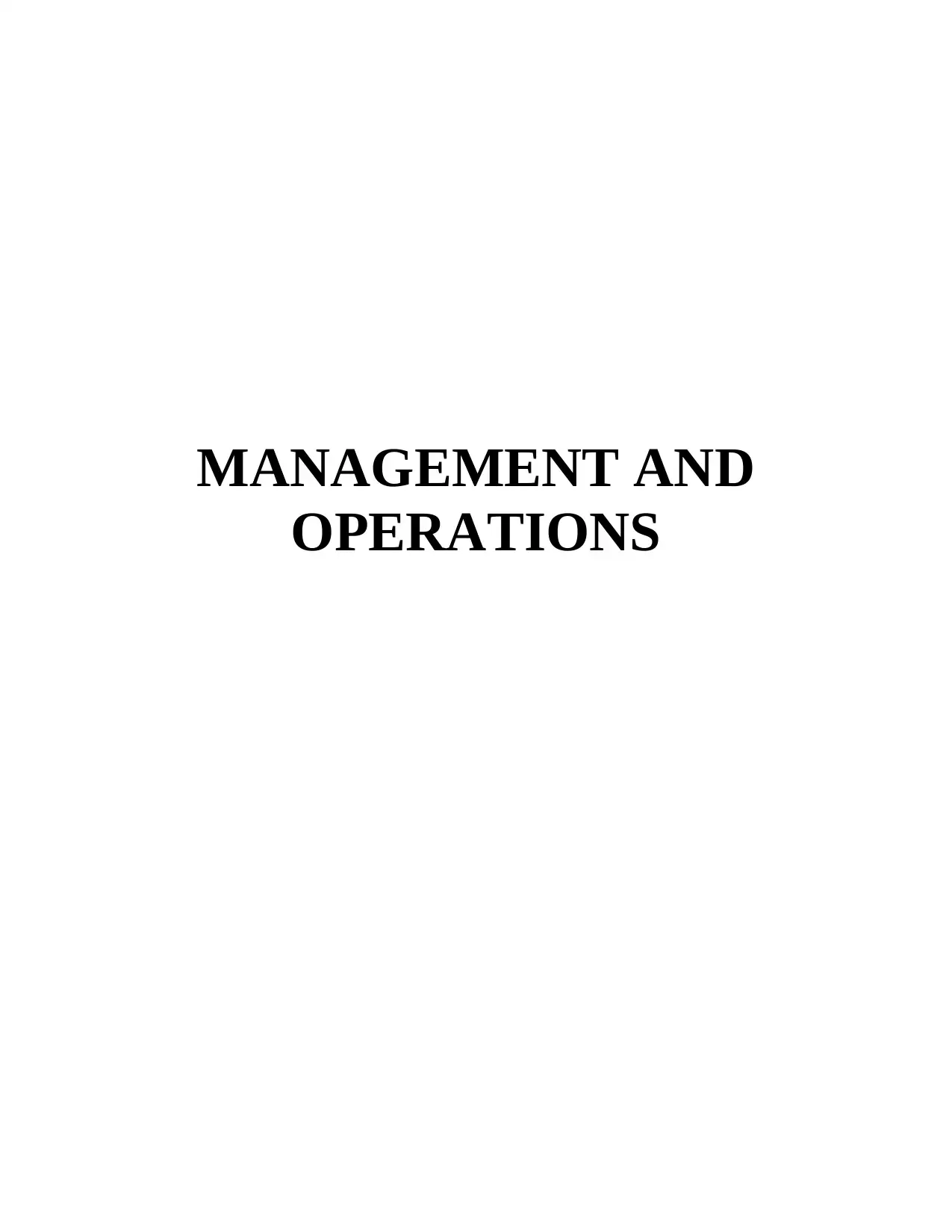
MANAGEMENT AND
OPERATIONS
OPERATIONS
Secure Best Marks with AI Grader
Need help grading? Try our AI Grader for instant feedback on your assignments.
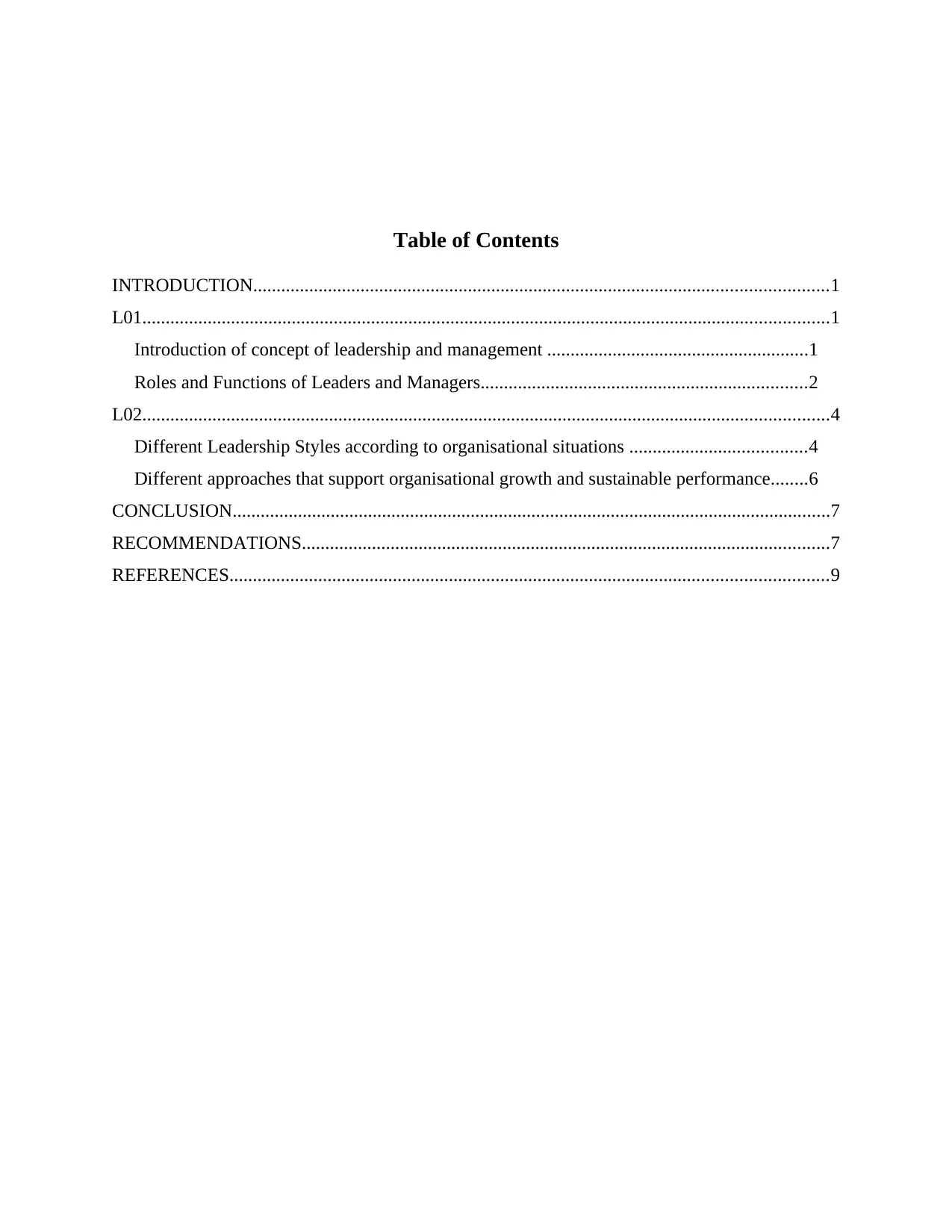
Table of Contents
INTRODUCTION...........................................................................................................................1
L01...................................................................................................................................................1
Introduction of concept of leadership and management ........................................................1
Roles and Functions of Leaders and Managers......................................................................2
L02...................................................................................................................................................4
Different Leadership Styles according to organisational situations ......................................4
Different approaches that support organisational growth and sustainable performance........6
CONCLUSION................................................................................................................................7
RECOMMENDATIONS.................................................................................................................7
REFERENCES................................................................................................................................9
INTRODUCTION...........................................................................................................................1
L01...................................................................................................................................................1
Introduction of concept of leadership and management ........................................................1
Roles and Functions of Leaders and Managers......................................................................2
L02...................................................................................................................................................4
Different Leadership Styles according to organisational situations ......................................4
Different approaches that support organisational growth and sustainable performance........6
CONCLUSION................................................................................................................................7
RECOMMENDATIONS.................................................................................................................7
REFERENCES................................................................................................................................9

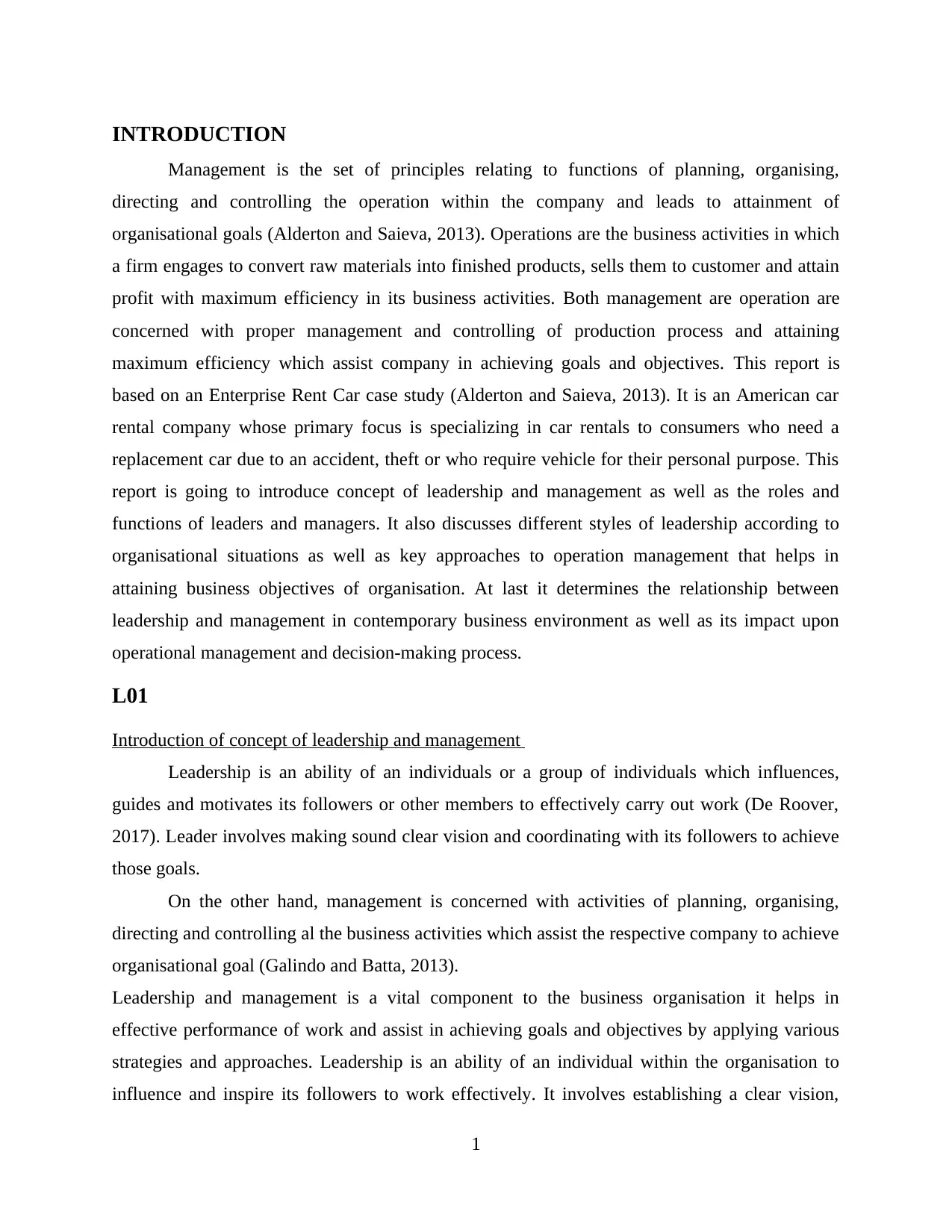
INTRODUCTION
Management is the set of principles relating to functions of planning, organising,
directing and controlling the operation within the company and leads to attainment of
organisational goals (Alderton and Saieva, 2013). Operations are the business activities in which
a firm engages to convert raw materials into finished products, sells them to customer and attain
profit with maximum efficiency in its business activities. Both management are operation are
concerned with proper management and controlling of production process and attaining
maximum efficiency which assist company in achieving goals and objectives. This report is
based on an Enterprise Rent Car case study (Alderton and Saieva, 2013). It is an American car
rental company whose primary focus is specializing in car rentals to consumers who need a
replacement car due to an accident, theft or who require vehicle for their personal purpose. This
report is going to introduce concept of leadership and management as well as the roles and
functions of leaders and managers. It also discusses different styles of leadership according to
organisational situations as well as key approaches to operation management that helps in
attaining business objectives of organisation. At last it determines the relationship between
leadership and management in contemporary business environment as well as its impact upon
operational management and decision-making process.
L01
Introduction of concept of leadership and management
Leadership is an ability of an individuals or a group of individuals which influences,
guides and motivates its followers or other members to effectively carry out work (De Roover,
2017). Leader involves making sound clear vision and coordinating with its followers to achieve
those goals.
On the other hand, management is concerned with activities of planning, organising,
directing and controlling al the business activities which assist the respective company to achieve
organisational goal (Galindo and Batta, 2013).
Leadership and management is a vital component to the business organisation it helps in
effective performance of work and assist in achieving goals and objectives by applying various
strategies and approaches. Leadership is an ability of an individual within the organisation to
influence and inspire its followers to work effectively. It involves establishing a clear vision,
1
Management is the set of principles relating to functions of planning, organising,
directing and controlling the operation within the company and leads to attainment of
organisational goals (Alderton and Saieva, 2013). Operations are the business activities in which
a firm engages to convert raw materials into finished products, sells them to customer and attain
profit with maximum efficiency in its business activities. Both management are operation are
concerned with proper management and controlling of production process and attaining
maximum efficiency which assist company in achieving goals and objectives. This report is
based on an Enterprise Rent Car case study (Alderton and Saieva, 2013). It is an American car
rental company whose primary focus is specializing in car rentals to consumers who need a
replacement car due to an accident, theft or who require vehicle for their personal purpose. This
report is going to introduce concept of leadership and management as well as the roles and
functions of leaders and managers. It also discusses different styles of leadership according to
organisational situations as well as key approaches to operation management that helps in
attaining business objectives of organisation. At last it determines the relationship between
leadership and management in contemporary business environment as well as its impact upon
operational management and decision-making process.
L01
Introduction of concept of leadership and management
Leadership is an ability of an individuals or a group of individuals which influences,
guides and motivates its followers or other members to effectively carry out work (De Roover,
2017). Leader involves making sound clear vision and coordinating with its followers to achieve
those goals.
On the other hand, management is concerned with activities of planning, organising,
directing and controlling al the business activities which assist the respective company to achieve
organisational goal (Galindo and Batta, 2013).
Leadership and management is a vital component to the business organisation it helps in
effective performance of work and assist in achieving goals and objectives by applying various
strategies and approaches. Leadership is an ability of an individual within the organisation to
influence and inspire its followers to work effectively. It involves establishing a clear vision,
1
Secure Best Marks with AI Grader
Need help grading? Try our AI Grader for instant feedback on your assignments.
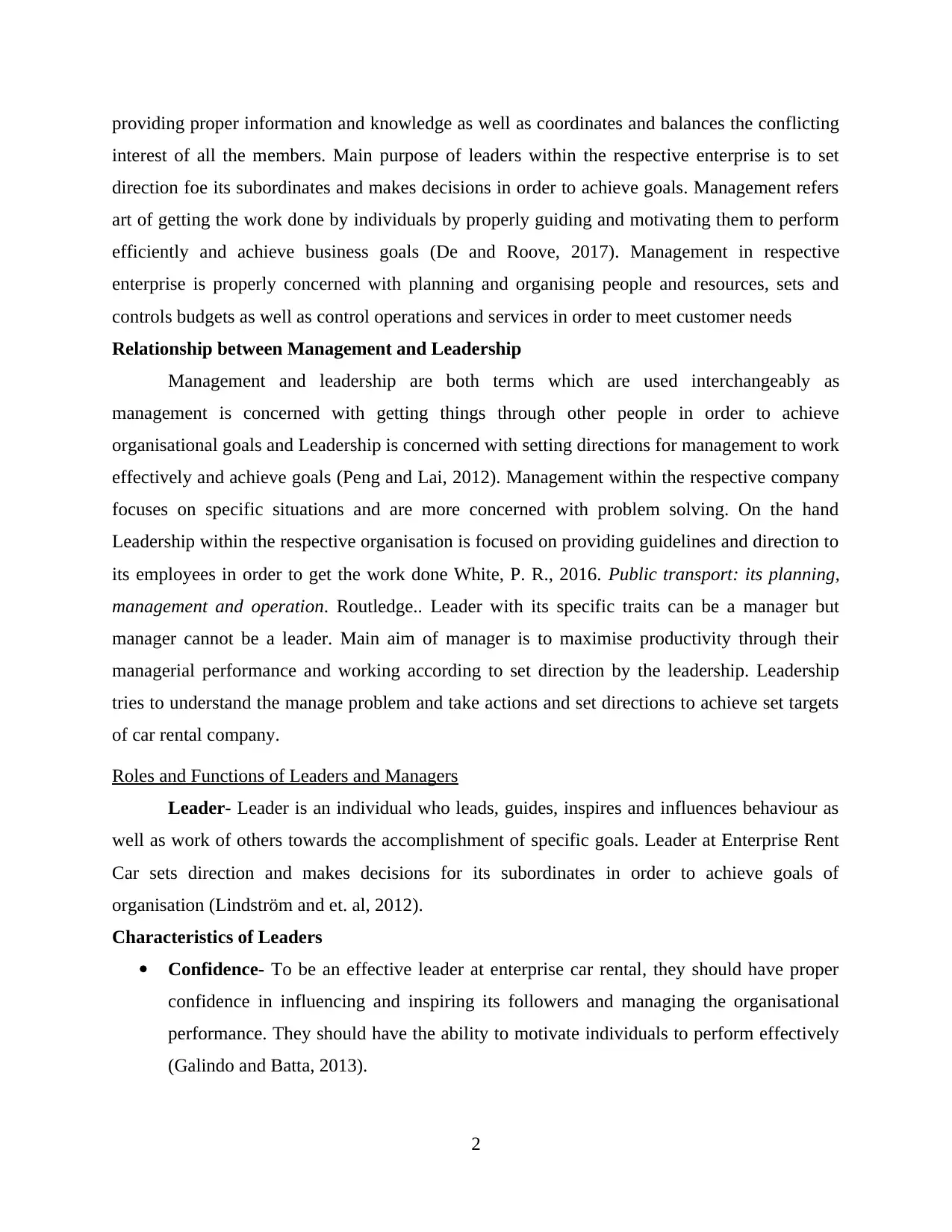
providing proper information and knowledge as well as coordinates and balances the conflicting
interest of all the members. Main purpose of leaders within the respective enterprise is to set
direction foe its subordinates and makes decisions in order to achieve goals. Management refers
art of getting the work done by individuals by properly guiding and motivating them to perform
efficiently and achieve business goals (De and Roove, 2017). Management in respective
enterprise is properly concerned with planning and organising people and resources, sets and
controls budgets as well as control operations and services in order to meet customer needs
Relationship between Management and Leadership
Management and leadership are both terms which are used interchangeably as
management is concerned with getting things through other people in order to achieve
organisational goals and Leadership is concerned with setting directions for management to work
effectively and achieve goals (Peng and Lai, 2012). Management within the respective company
focuses on specific situations and are more concerned with problem solving. On the hand
Leadership within the respective organisation is focused on providing guidelines and direction to
its employees in order to get the work done White, P. R., 2016. Public transport: its planning,
management and operation. Routledge.. Leader with its specific traits can be a manager but
manager cannot be a leader. Main aim of manager is to maximise productivity through their
managerial performance and working according to set direction by the leadership. Leadership
tries to understand the manage problem and take actions and set directions to achieve set targets
of car rental company.
Roles and Functions of Leaders and Managers
Leader- Leader is an individual who leads, guides, inspires and influences behaviour as
well as work of others towards the accomplishment of specific goals. Leader at Enterprise Rent
Car sets direction and makes decisions for its subordinates in order to achieve goals of
organisation (Lindström and et. al, 2012).
Characteristics of Leaders
Confidence- To be an effective leader at enterprise car rental, they should have proper
confidence in influencing and inspiring its followers and managing the organisational
performance. They should have the ability to motivate individuals to perform effectively
(Galindo and Batta, 2013).
2
interest of all the members. Main purpose of leaders within the respective enterprise is to set
direction foe its subordinates and makes decisions in order to achieve goals. Management refers
art of getting the work done by individuals by properly guiding and motivating them to perform
efficiently and achieve business goals (De and Roove, 2017). Management in respective
enterprise is properly concerned with planning and organising people and resources, sets and
controls budgets as well as control operations and services in order to meet customer needs
Relationship between Management and Leadership
Management and leadership are both terms which are used interchangeably as
management is concerned with getting things through other people in order to achieve
organisational goals and Leadership is concerned with setting directions for management to work
effectively and achieve goals (Peng and Lai, 2012). Management within the respective company
focuses on specific situations and are more concerned with problem solving. On the hand
Leadership within the respective organisation is focused on providing guidelines and direction to
its employees in order to get the work done White, P. R., 2016. Public transport: its planning,
management and operation. Routledge.. Leader with its specific traits can be a manager but
manager cannot be a leader. Main aim of manager is to maximise productivity through their
managerial performance and working according to set direction by the leadership. Leadership
tries to understand the manage problem and take actions and set directions to achieve set targets
of car rental company.
Roles and Functions of Leaders and Managers
Leader- Leader is an individual who leads, guides, inspires and influences behaviour as
well as work of others towards the accomplishment of specific goals. Leader at Enterprise Rent
Car sets direction and makes decisions for its subordinates in order to achieve goals of
organisation (Lindström and et. al, 2012).
Characteristics of Leaders
Confidence- To be an effective leader at enterprise car rental, they should have proper
confidence in influencing and inspiring its followers and managing the organisational
performance. They should have the ability to motivate individuals to perform effectively
(Galindo and Batta, 2013).
2
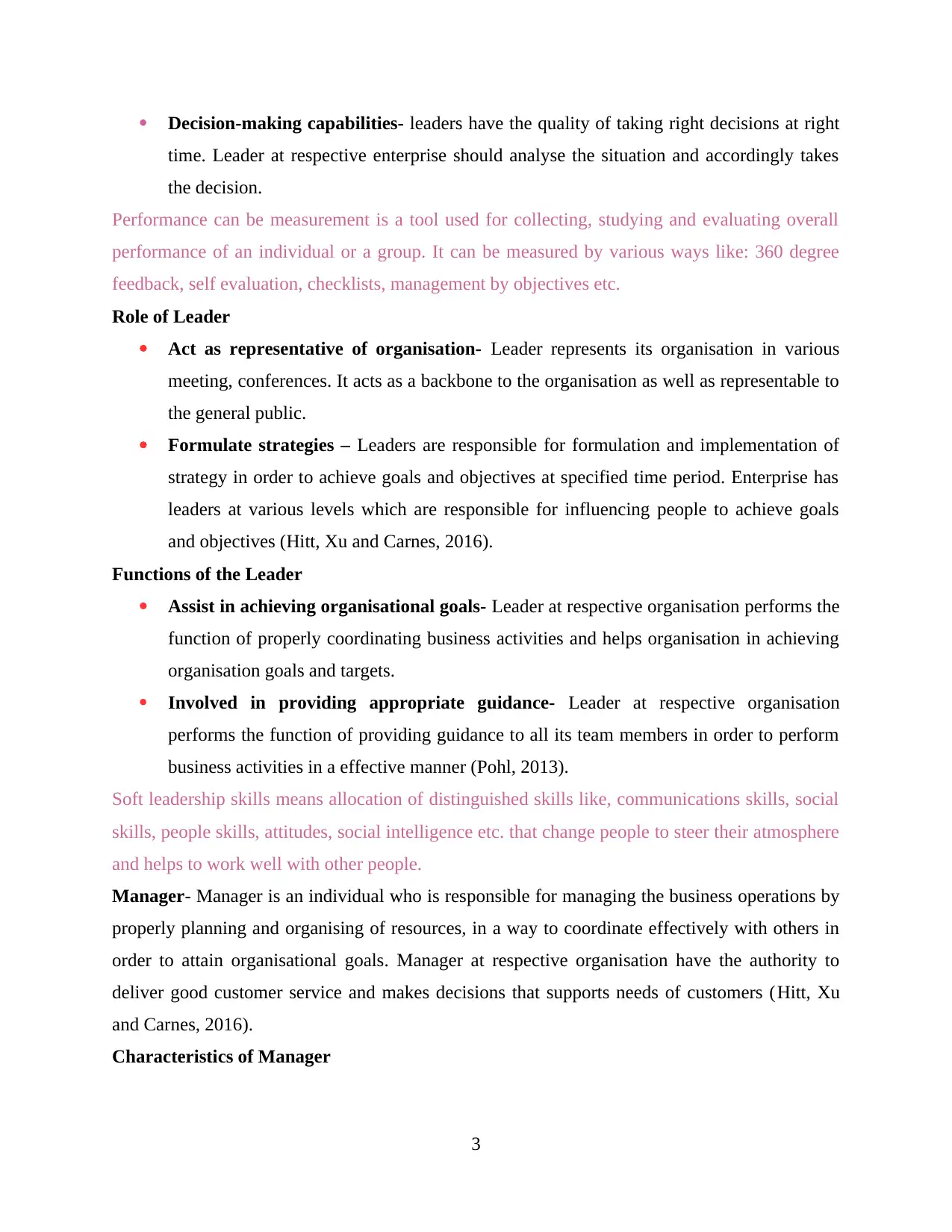
Decision-making capabilities- leaders have the quality of taking right decisions at right
time. Leader at respective enterprise should analyse the situation and accordingly takes
the decision.
Performance can be measurement is a tool used for collecting, studying and evaluating overall
performance of an individual or a group. It can be measured by various ways like: 360 degree
feedback, self evaluation, checklists, management by objectives etc.
Role of Leader
Act as representative of organisation- Leader represents its organisation in various
meeting, conferences. It acts as a backbone to the organisation as well as representable to
the general public.
Formulate strategies – Leaders are responsible for formulation and implementation of
strategy in order to achieve goals and objectives at specified time period. Enterprise has
leaders at various levels which are responsible for influencing people to achieve goals
and objectives (Hitt, Xu and Carnes, 2016).
Functions of the Leader
Assist in achieving organisational goals- Leader at respective organisation performs the
function of properly coordinating business activities and helps organisation in achieving
organisation goals and targets.
Involved in providing appropriate guidance- Leader at respective organisation
performs the function of providing guidance to all its team members in order to perform
business activities in a effective manner (Pohl, 2013).
Soft leadership skills means allocation of distinguished skills like, communications skills, social
skills, people skills, attitudes, social intelligence etc. that change people to steer their atmosphere
and helps to work well with other people.
Manager- Manager is an individual who is responsible for managing the business operations by
properly planning and organising of resources, in a way to coordinate effectively with others in
order to attain organisational goals. Manager at respective organisation have the authority to
deliver good customer service and makes decisions that supports needs of customers (Hitt, Xu
and Carnes, 2016).
Characteristics of Manager
3
time. Leader at respective enterprise should analyse the situation and accordingly takes
the decision.
Performance can be measurement is a tool used for collecting, studying and evaluating overall
performance of an individual or a group. It can be measured by various ways like: 360 degree
feedback, self evaluation, checklists, management by objectives etc.
Role of Leader
Act as representative of organisation- Leader represents its organisation in various
meeting, conferences. It acts as a backbone to the organisation as well as representable to
the general public.
Formulate strategies – Leaders are responsible for formulation and implementation of
strategy in order to achieve goals and objectives at specified time period. Enterprise has
leaders at various levels which are responsible for influencing people to achieve goals
and objectives (Hitt, Xu and Carnes, 2016).
Functions of the Leader
Assist in achieving organisational goals- Leader at respective organisation performs the
function of properly coordinating business activities and helps organisation in achieving
organisation goals and targets.
Involved in providing appropriate guidance- Leader at respective organisation
performs the function of providing guidance to all its team members in order to perform
business activities in a effective manner (Pohl, 2013).
Soft leadership skills means allocation of distinguished skills like, communications skills, social
skills, people skills, attitudes, social intelligence etc. that change people to steer their atmosphere
and helps to work well with other people.
Manager- Manager is an individual who is responsible for managing the business operations by
properly planning and organising of resources, in a way to coordinate effectively with others in
order to attain organisational goals. Manager at respective organisation have the authority to
deliver good customer service and makes decisions that supports needs of customers (Hitt, Xu
and Carnes, 2016).
Characteristics of Manager
3
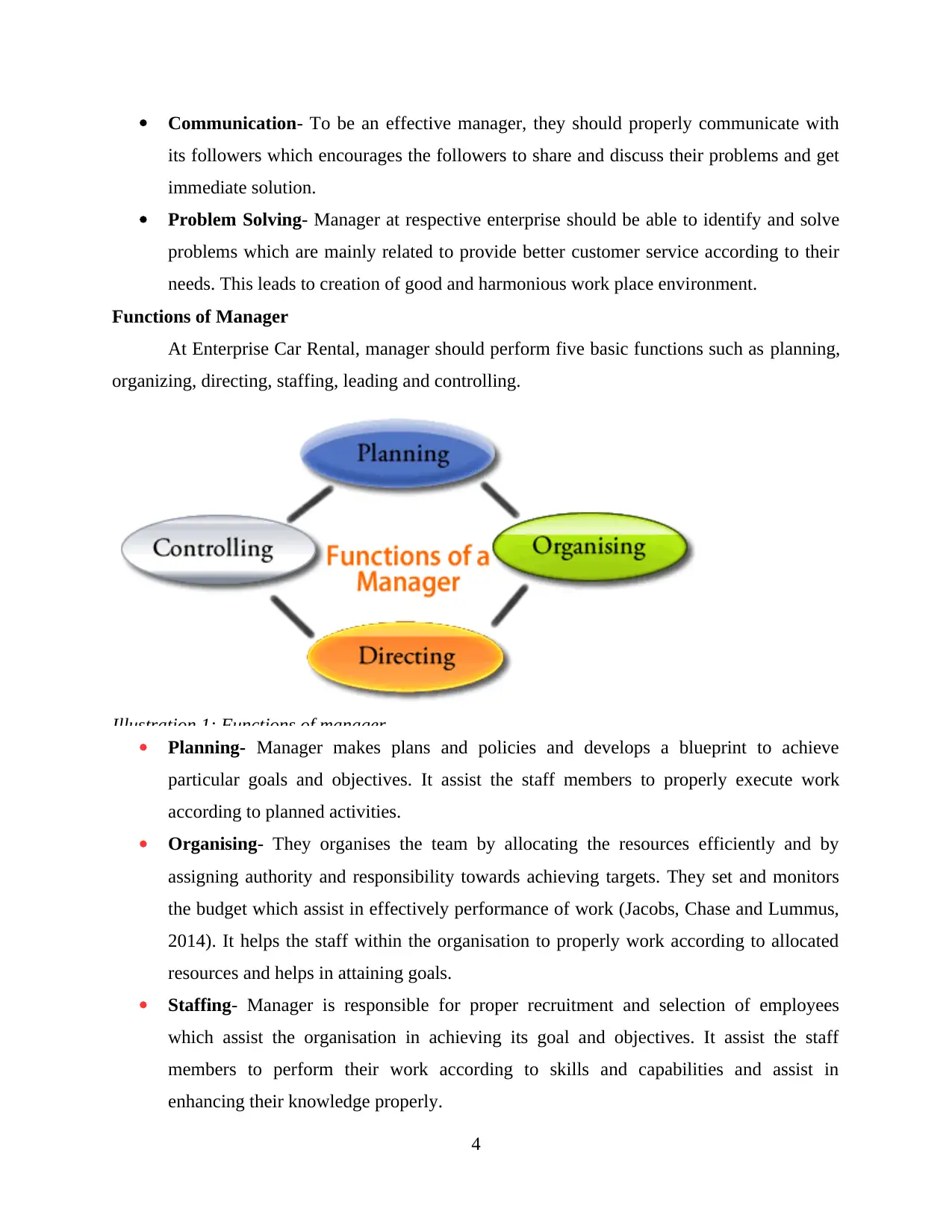
Communication- To be an effective manager, they should properly communicate with
its followers which encourages the followers to share and discuss their problems and get
immediate solution.
Problem Solving- Manager at respective enterprise should be able to identify and solve
problems which are mainly related to provide better customer service according to their
needs. This leads to creation of good and harmonious work place environment.
Functions of Manager
At Enterprise Car Rental, manager should perform five basic functions such as planning,
organizing, directing, staffing, leading and controlling.
Illustration 1: Functions of manager
Planning- Manager makes plans and policies and develops a blueprint to achieve
particular goals and objectives. It assist the staff members to properly execute work
according to planned activities.
Organising- They organises the team by allocating the resources efficiently and by
assigning authority and responsibility towards achieving targets. They set and monitors
the budget which assist in effectively performance of work (Jacobs, Chase and Lummus,
2014). It helps the staff within the organisation to properly work according to allocated
resources and helps in attaining goals.
Staffing- Manager is responsible for proper recruitment and selection of employees
which assist the organisation in achieving its goal and objectives. It assist the staff
members to perform their work according to skills and capabilities and assist in
enhancing their knowledge properly.
4
its followers which encourages the followers to share and discuss their problems and get
immediate solution.
Problem Solving- Manager at respective enterprise should be able to identify and solve
problems which are mainly related to provide better customer service according to their
needs. This leads to creation of good and harmonious work place environment.
Functions of Manager
At Enterprise Car Rental, manager should perform five basic functions such as planning,
organizing, directing, staffing, leading and controlling.
Illustration 1: Functions of manager
Planning- Manager makes plans and policies and develops a blueprint to achieve
particular goals and objectives. It assist the staff members to properly execute work
according to planned activities.
Organising- They organises the team by allocating the resources efficiently and by
assigning authority and responsibility towards achieving targets. They set and monitors
the budget which assist in effectively performance of work (Jacobs, Chase and Lummus,
2014). It helps the staff within the organisation to properly work according to allocated
resources and helps in attaining goals.
Staffing- Manager is responsible for proper recruitment and selection of employees
which assist the organisation in achieving its goal and objectives. It assist the staff
members to perform their work according to skills and capabilities and assist in
enhancing their knowledge properly.
4
Paraphrase This Document
Need a fresh take? Get an instant paraphrase of this document with our AI Paraphraser
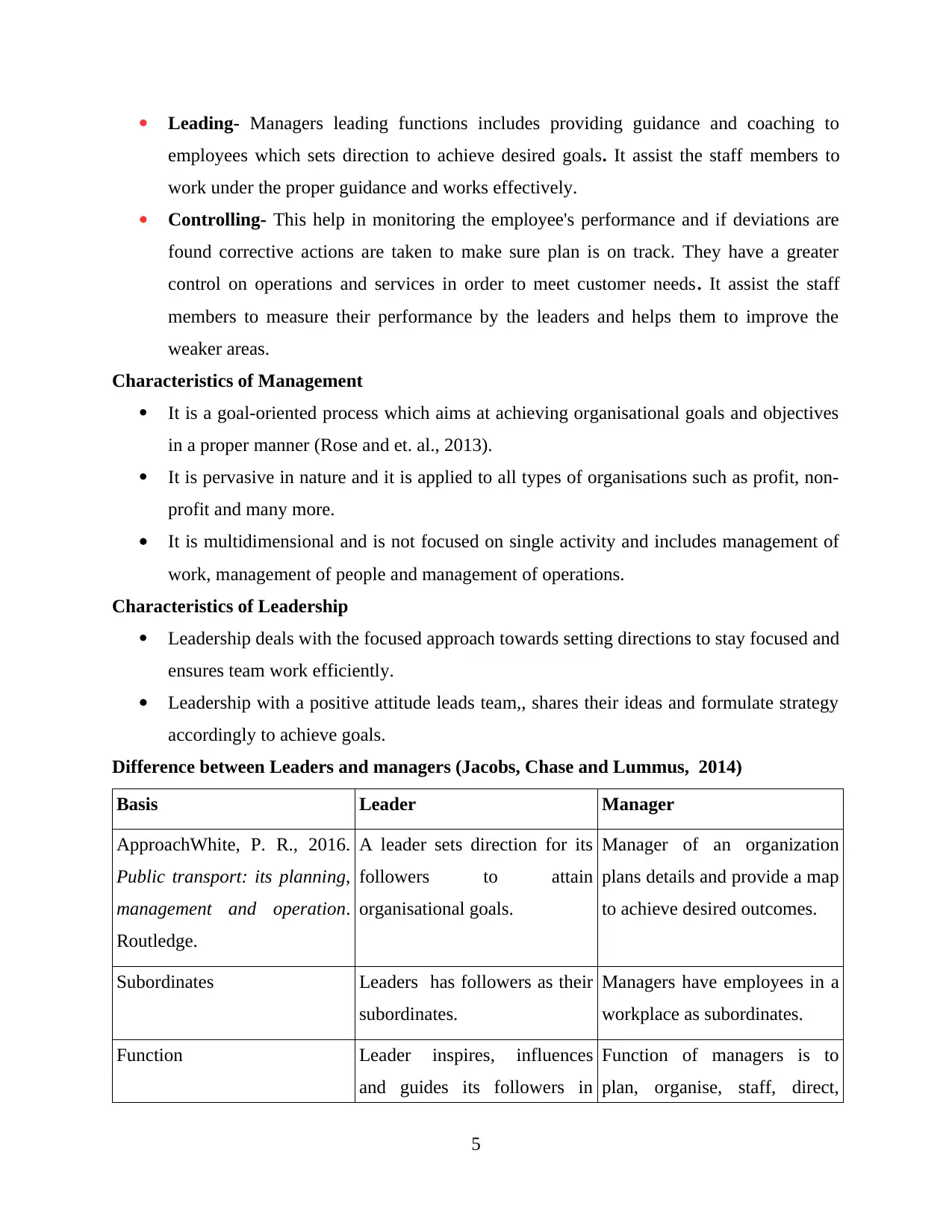
Leading- Managers leading functions includes providing guidance and coaching to
employees which sets direction to achieve desired goals. It assist the staff members to
work under the proper guidance and works effectively.
Controlling- This help in monitoring the employee's performance and if deviations are
found corrective actions are taken to make sure plan is on track. They have a greater
control on operations and services in order to meet customer needs. It assist the staff
members to measure their performance by the leaders and helps them to improve the
weaker areas.
Characteristics of Management
It is a goal-oriented process which aims at achieving organisational goals and objectives
in a proper manner (Rose and et. al., 2013).
It is pervasive in nature and it is applied to all types of organisations such as profit, non-
profit and many more.
It is multidimensional and is not focused on single activity and includes management of
work, management of people and management of operations.
Characteristics of Leadership
Leadership deals with the focused approach towards setting directions to stay focused and
ensures team work efficiently.
Leadership with a positive attitude leads team,, shares their ideas and formulate strategy
accordingly to achieve goals.
Difference between Leaders and managers (Jacobs, Chase and Lummus, 2014)
Basis Leader Manager
ApproachWhite, P. R., 2016.
Public transport: its planning,
management and operation.
Routledge.
A leader sets direction for its
followers to attain
organisational goals.
Manager of an organization
plans details and provide a map
to achieve desired outcomes.
Subordinates Leaders has followers as their
subordinates.
Managers have employees in a
workplace as subordinates.
Function Leader inspires, influences
and guides its followers in
Function of managers is to
plan, organise, staff, direct,
5
employees which sets direction to achieve desired goals. It assist the staff members to
work under the proper guidance and works effectively.
Controlling- This help in monitoring the employee's performance and if deviations are
found corrective actions are taken to make sure plan is on track. They have a greater
control on operations and services in order to meet customer needs. It assist the staff
members to measure their performance by the leaders and helps them to improve the
weaker areas.
Characteristics of Management
It is a goal-oriented process which aims at achieving organisational goals and objectives
in a proper manner (Rose and et. al., 2013).
It is pervasive in nature and it is applied to all types of organisations such as profit, non-
profit and many more.
It is multidimensional and is not focused on single activity and includes management of
work, management of people and management of operations.
Characteristics of Leadership
Leadership deals with the focused approach towards setting directions to stay focused and
ensures team work efficiently.
Leadership with a positive attitude leads team,, shares their ideas and formulate strategy
accordingly to achieve goals.
Difference between Leaders and managers (Jacobs, Chase and Lummus, 2014)
Basis Leader Manager
ApproachWhite, P. R., 2016.
Public transport: its planning,
management and operation.
Routledge.
A leader sets direction for its
followers to attain
organisational goals.
Manager of an organization
plans details and provide a map
to achieve desired outcomes.
Subordinates Leaders has followers as their
subordinates.
Managers have employees in a
workplace as subordinates.
Function Leader inspires, influences
and guides its followers in
Function of managers is to
plan, organise, staff, direct,
5
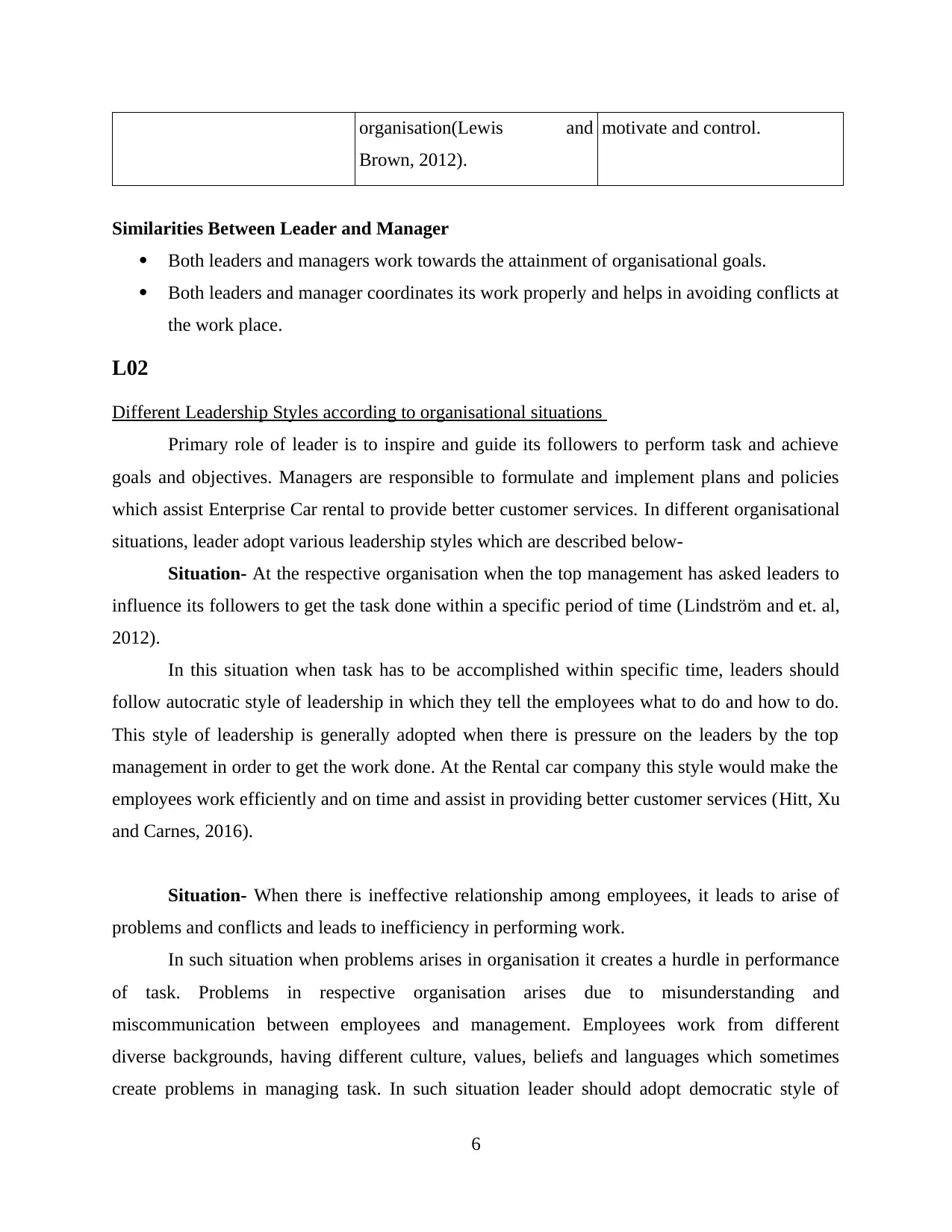
organisation(Lewis and
Brown, 2012).
motivate and control.
Similarities Between Leader and Manager
Both leaders and managers work towards the attainment of organisational goals.
Both leaders and manager coordinates its work properly and helps in avoiding conflicts at
the work place.
L02
Different Leadership Styles according to organisational situations
Primary role of leader is to inspire and guide its followers to perform task and achieve
goals and objectives. Managers are responsible to formulate and implement plans and policies
which assist Enterprise Car rental to provide better customer services. In different organisational
situations, leader adopt various leadership styles which are described below-
Situation- At the respective organisation when the top management has asked leaders to
influence its followers to get the task done within a specific period of time (Lindström and et. al,
2012).
In this situation when task has to be accomplished within specific time, leaders should
follow autocratic style of leadership in which they tell the employees what to do and how to do.
This style of leadership is generally adopted when there is pressure on the leaders by the top
management in order to get the work done. At the Rental car company this style would make the
employees work efficiently and on time and assist in providing better customer services (Hitt, Xu
and Carnes, 2016).
Situation- When there is ineffective relationship among employees, it leads to arise of
problems and conflicts and leads to inefficiency in performing work.
In such situation when problems arises in organisation it creates a hurdle in performance
of task. Problems in respective organisation arises due to misunderstanding and
miscommunication between employees and management. Employees work from different
diverse backgrounds, having different culture, values, beliefs and languages which sometimes
create problems in managing task. In such situation leader should adopt democratic style of
6
Brown, 2012).
motivate and control.
Similarities Between Leader and Manager
Both leaders and managers work towards the attainment of organisational goals.
Both leaders and manager coordinates its work properly and helps in avoiding conflicts at
the work place.
L02
Different Leadership Styles according to organisational situations
Primary role of leader is to inspire and guide its followers to perform task and achieve
goals and objectives. Managers are responsible to formulate and implement plans and policies
which assist Enterprise Car rental to provide better customer services. In different organisational
situations, leader adopt various leadership styles which are described below-
Situation- At the respective organisation when the top management has asked leaders to
influence its followers to get the task done within a specific period of time (Lindström and et. al,
2012).
In this situation when task has to be accomplished within specific time, leaders should
follow autocratic style of leadership in which they tell the employees what to do and how to do.
This style of leadership is generally adopted when there is pressure on the leaders by the top
management in order to get the work done. At the Rental car company this style would make the
employees work efficiently and on time and assist in providing better customer services (Hitt, Xu
and Carnes, 2016).
Situation- When there is ineffective relationship among employees, it leads to arise of
problems and conflicts and leads to inefficiency in performing work.
In such situation when problems arises in organisation it creates a hurdle in performance
of task. Problems in respective organisation arises due to misunderstanding and
miscommunication between employees and management. Employees work from different
diverse backgrounds, having different culture, values, beliefs and languages which sometimes
create problems in managing task. In such situation leader should adopt democratic style of
6
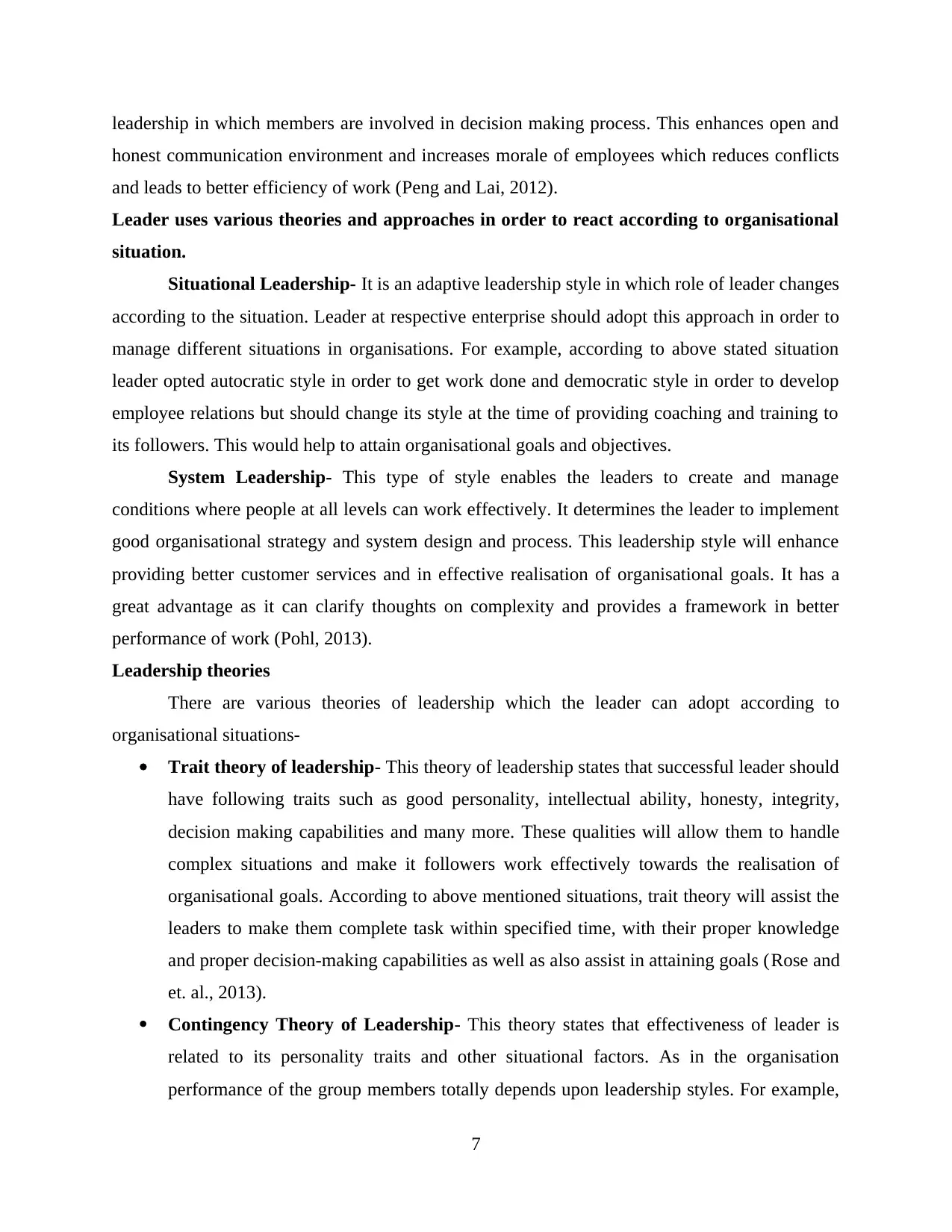
leadership in which members are involved in decision making process. This enhances open and
honest communication environment and increases morale of employees which reduces conflicts
and leads to better efficiency of work (Peng and Lai, 2012).
Leader uses various theories and approaches in order to react according to organisational
situation.
Situational Leadership- It is an adaptive leadership style in which role of leader changes
according to the situation. Leader at respective enterprise should adopt this approach in order to
manage different situations in organisations. For example, according to above stated situation
leader opted autocratic style in order to get work done and democratic style in order to develop
employee relations but should change its style at the time of providing coaching and training to
its followers. This would help to attain organisational goals and objectives.
System Leadership- This type of style enables the leaders to create and manage
conditions where people at all levels can work effectively. It determines the leader to implement
good organisational strategy and system design and process. This leadership style will enhance
providing better customer services and in effective realisation of organisational goals. It has a
great advantage as it can clarify thoughts on complexity and provides a framework in better
performance of work (Pohl, 2013).
Leadership theories
There are various theories of leadership which the leader can adopt according to
organisational situations-
Trait theory of leadership- This theory of leadership states that successful leader should
have following traits such as good personality, intellectual ability, honesty, integrity,
decision making capabilities and many more. These qualities will allow them to handle
complex situations and make it followers work effectively towards the realisation of
organisational goals. According to above mentioned situations, trait theory will assist the
leaders to make them complete task within specified time, with their proper knowledge
and proper decision-making capabilities as well as also assist in attaining goals (Rose and
et. al., 2013).
Contingency Theory of Leadership- This theory states that effectiveness of leader is
related to its personality traits and other situational factors. As in the organisation
performance of the group members totally depends upon leadership styles. For example,
7
honest communication environment and increases morale of employees which reduces conflicts
and leads to better efficiency of work (Peng and Lai, 2012).
Leader uses various theories and approaches in order to react according to organisational
situation.
Situational Leadership- It is an adaptive leadership style in which role of leader changes
according to the situation. Leader at respective enterprise should adopt this approach in order to
manage different situations in organisations. For example, according to above stated situation
leader opted autocratic style in order to get work done and democratic style in order to develop
employee relations but should change its style at the time of providing coaching and training to
its followers. This would help to attain organisational goals and objectives.
System Leadership- This type of style enables the leaders to create and manage
conditions where people at all levels can work effectively. It determines the leader to implement
good organisational strategy and system design and process. This leadership style will enhance
providing better customer services and in effective realisation of organisational goals. It has a
great advantage as it can clarify thoughts on complexity and provides a framework in better
performance of work (Pohl, 2013).
Leadership theories
There are various theories of leadership which the leader can adopt according to
organisational situations-
Trait theory of leadership- This theory of leadership states that successful leader should
have following traits such as good personality, intellectual ability, honesty, integrity,
decision making capabilities and many more. These qualities will allow them to handle
complex situations and make it followers work effectively towards the realisation of
organisational goals. According to above mentioned situations, trait theory will assist the
leaders to make them complete task within specified time, with their proper knowledge
and proper decision-making capabilities as well as also assist in attaining goals (Rose and
et. al., 2013).
Contingency Theory of Leadership- This theory states that effectiveness of leader is
related to its personality traits and other situational factors. As in the organisation
performance of the group members totally depends upon leadership styles. For example,
7
Secure Best Marks with AI Grader
Need help grading? Try our AI Grader for instant feedback on your assignments.

task-oriented leaders generally focus on getting the work done by individuals and
relationship-oriented leaders tend to make harmonious relationship at work place. Hence,
leader should behave according to the situation prevailing at work place. According to
above mentioned situation, in order to reduce conflicts and problems, leader should opt
for relationship-oriented theory in order to make friendly atmosphere in organisation and
allow employees to work effectively (Schönsleben, 2016).
Different approaches that support organisational growth and sustainable performance.
Various approaches that will supports organisational growth and sustainable performance
are explained below-
Management by Objectives- MBO is a performance management approach in which
managers and employees work together to set, record and monitor goals for a specific period of
time. It requires that employees should set measurable personal goals based upon organisational
goals (Slack and Brandon-Jones, 2018). This approach helps in proper alignment and
coordination of individual goals. This approach can be useful for the respective enterprise growth
and sustainable performance. Employees at Car Rental company should monitor their
performance and therefore makes plans and set targets in order to support growth and long-term
sustainability of business (Slack and BrandonJones, 2018).
Chaos Theory- This theory of management states that slight change in the market may
lead to change in demand from the customers. It states that organisation must be capable enough
to adapt to these changes and work according to different situations. From respective
organisation's point of view, company and employees should get adapted to the situation and
formulate their goals and strategy accordingly to achieve set targets. It the enterprise experience
certain change in pattern of demand, they should change their services and design new products
in order to provide better customer service (Sodhi, Son and Tang, 2012).
Management of Car Rental Company helps in identification of chaos in environment and
accordingly helps in framing of strategies. This would help organisation in maintaining growth
and long-term sustainability of its business.
Action Leadership approach- In this approach managers of the respective company
takes the decision according to the situation and enhances team productivity and assist the
organisation in gaining more profitability. When managers react according to the situation it
assist the employees to work effectively (Lewis and Brown, 2012).
8
relationship-oriented leaders tend to make harmonious relationship at work place. Hence,
leader should behave according to the situation prevailing at work place. According to
above mentioned situation, in order to reduce conflicts and problems, leader should opt
for relationship-oriented theory in order to make friendly atmosphere in organisation and
allow employees to work effectively (Schönsleben, 2016).
Different approaches that support organisational growth and sustainable performance.
Various approaches that will supports organisational growth and sustainable performance
are explained below-
Management by Objectives- MBO is a performance management approach in which
managers and employees work together to set, record and monitor goals for a specific period of
time. It requires that employees should set measurable personal goals based upon organisational
goals (Slack and Brandon-Jones, 2018). This approach helps in proper alignment and
coordination of individual goals. This approach can be useful for the respective enterprise growth
and sustainable performance. Employees at Car Rental company should monitor their
performance and therefore makes plans and set targets in order to support growth and long-term
sustainability of business (Slack and BrandonJones, 2018).
Chaos Theory- This theory of management states that slight change in the market may
lead to change in demand from the customers. It states that organisation must be capable enough
to adapt to these changes and work according to different situations. From respective
organisation's point of view, company and employees should get adapted to the situation and
formulate their goals and strategy accordingly to achieve set targets. It the enterprise experience
certain change in pattern of demand, they should change their services and design new products
in order to provide better customer service (Sodhi, Son and Tang, 2012).
Management of Car Rental Company helps in identification of chaos in environment and
accordingly helps in framing of strategies. This would help organisation in maintaining growth
and long-term sustainability of its business.
Action Leadership approach- In this approach managers of the respective company
takes the decision according to the situation and enhances team productivity and assist the
organisation in gaining more profitability. When managers react according to the situation it
assist the employees to work effectively (Lewis and Brown, 2012).
8

Transformational Leadership Theory- This approach says that employees can
participate in decision making process, this makes the employees to work collectively and assist
organisation in achieving goals and objectives and support organisational growth and sustainable
performance.
Theory X means that style used where the focus is on productivity, on reward performance and
evils of feather bedding and restriction of output that shows inherent tendency of human to avoid
work. Whereas Theory Y defines that people take their work as a challenge then firm should use
participative management style to build work ownership between people and work so, they
perform effectively and efficiently.
CONCLUSION
Managers and Leaders play a crucial role in successful performance of business
operations at respective enterprise. They inspire, motivate, guides the employees in performing
the work effectively and assist in attainment of organisational goals. By proper planning and
allocation of resources it makes the business activities get completed on time. Managers and
Leaders greatly impacts the business organisation as with the use of various leadership theories
and models it helps in providing proper guidance to the employee to work effectively and attain
organisational goals.
RECOMMENDATIONS
It is highly recommended for the Managers and Leaders of Enterprise Car Rental company that-
In order to maintain effective relationship, leaders and managers should use democratic
style of leadership which involves all its employees in decision making which makes
them highly motivated to perform task.
Leaders and managers should analyse the need for training and provide training facilities
to its customers in order to enhance their skills and make them work efficiently.
In order to motivate them managers and leaders should link their performance with
rewards which encourages employees to perform effectively.
9
participate in decision making process, this makes the employees to work collectively and assist
organisation in achieving goals and objectives and support organisational growth and sustainable
performance.
Theory X means that style used where the focus is on productivity, on reward performance and
evils of feather bedding and restriction of output that shows inherent tendency of human to avoid
work. Whereas Theory Y defines that people take their work as a challenge then firm should use
participative management style to build work ownership between people and work so, they
perform effectively and efficiently.
CONCLUSION
Managers and Leaders play a crucial role in successful performance of business
operations at respective enterprise. They inspire, motivate, guides the employees in performing
the work effectively and assist in attainment of organisational goals. By proper planning and
allocation of resources it makes the business activities get completed on time. Managers and
Leaders greatly impacts the business organisation as with the use of various leadership theories
and models it helps in providing proper guidance to the employee to work effectively and attain
organisational goals.
RECOMMENDATIONS
It is highly recommended for the Managers and Leaders of Enterprise Car Rental company that-
In order to maintain effective relationship, leaders and managers should use democratic
style of leadership which involves all its employees in decision making which makes
them highly motivated to perform task.
Leaders and managers should analyse the need for training and provide training facilities
to its customers in order to enhance their skills and make them work efficiently.
In order to motivate them managers and leaders should link their performance with
rewards which encourages employees to perform effectively.
9

10
Paraphrase This Document
Need a fresh take? Get an instant paraphrase of this document with our AI Paraphraser
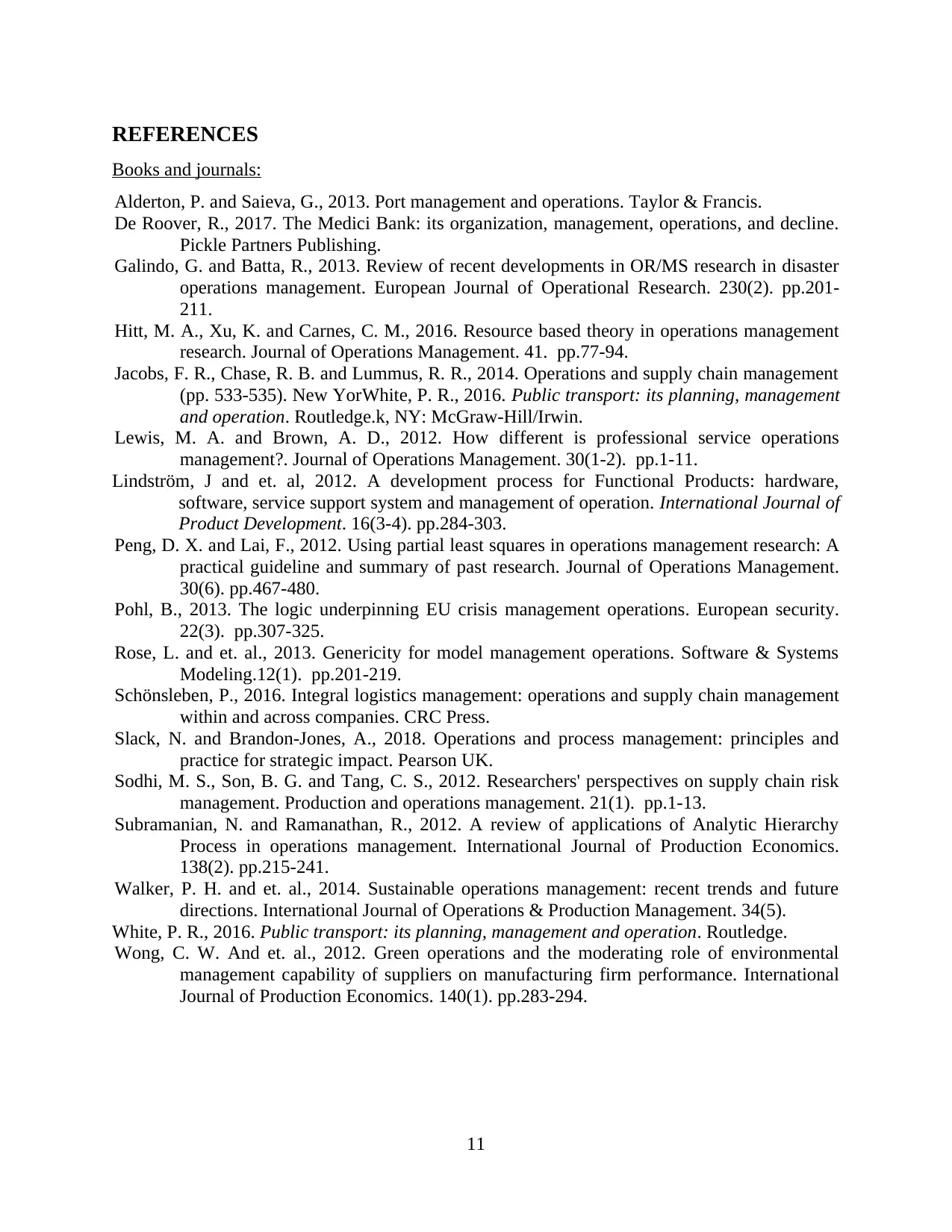
REFERENCES
Books and journals:
Alderton, P. and Saieva, G., 2013. Port management and operations. Taylor & Francis.
De Roover, R., 2017. The Medici Bank: its organization, management, operations, and decline.
Pickle Partners Publishing.
Galindo, G. and Batta, R., 2013. Review of recent developments in OR/MS research in disaster
operations management. European Journal of Operational Research. 230(2). pp.201-
211.
Hitt, M. A., Xu, K. and Carnes, C. M., 2016. Resource based theory in operations management
research. Journal of Operations Management. 41. pp.77-94.
Jacobs, F. R., Chase, R. B. and Lummus, R. R., 2014. Operations and supply chain management
(pp. 533-535). New YorWhite, P. R., 2016. Public transport: its planning, management
and operation. Routledge.k, NY: McGraw-Hill/Irwin.
Lewis, M. A. and Brown, A. D., 2012. How different is professional service operations
management?. Journal of Operations Management. 30(1-2). pp.1-11.
Lindström, J and et. al, 2012. A development process for Functional Products: hardware,
software, service support system and management of operation. International Journal of
Product Development. 16(3-4). pp.284-303.
Peng, D. X. and Lai, F., 2012. Using partial least squares in operations management research: A
practical guideline and summary of past research. Journal of Operations Management.
30(6). pp.467-480.
Pohl, B., 2013. The logic underpinning EU crisis management operations. European security.
22(3). pp.307-325.
Rose, L. and et. al., 2013. Genericity for model management operations. Software & Systems
Modeling.12(1). pp.201-219.
Schönsleben, P., 2016. Integral logistics management: operations and supply chain management
within and across companies. CRC Press.
Slack, N. and Brandon-Jones, A., 2018. Operations and process management: principles and
practice for strategic impact. Pearson UK.
Sodhi, M. S., Son, B. G. and Tang, C. S., 2012. Researchers' perspectives on supply chain risk
management. Production and operations management. 21(1). pp.1-13.
Subramanian, N. and Ramanathan, R., 2012. A review of applications of Analytic Hierarchy
Process in operations management. International Journal of Production Economics.
138(2). pp.215-241.
Walker, P. H. and et. al., 2014. Sustainable operations management: recent trends and future
directions. International Journal of Operations & Production Management. 34(5).
White, P. R., 2016. Public transport: its planning, management and operation. Routledge.
Wong, C. W. And et. al., 2012. Green operations and the moderating role of environmental
management capability of suppliers on manufacturing firm performance. International
Journal of Production Economics. 140(1). pp.283-294.
11
Books and journals:
Alderton, P. and Saieva, G., 2013. Port management and operations. Taylor & Francis.
De Roover, R., 2017. The Medici Bank: its organization, management, operations, and decline.
Pickle Partners Publishing.
Galindo, G. and Batta, R., 2013. Review of recent developments in OR/MS research in disaster
operations management. European Journal of Operational Research. 230(2). pp.201-
211.
Hitt, M. A., Xu, K. and Carnes, C. M., 2016. Resource based theory in operations management
research. Journal of Operations Management. 41. pp.77-94.
Jacobs, F. R., Chase, R. B. and Lummus, R. R., 2014. Operations and supply chain management
(pp. 533-535). New YorWhite, P. R., 2016. Public transport: its planning, management
and operation. Routledge.k, NY: McGraw-Hill/Irwin.
Lewis, M. A. and Brown, A. D., 2012. How different is professional service operations
management?. Journal of Operations Management. 30(1-2). pp.1-11.
Lindström, J and et. al, 2012. A development process for Functional Products: hardware,
software, service support system and management of operation. International Journal of
Product Development. 16(3-4). pp.284-303.
Peng, D. X. and Lai, F., 2012. Using partial least squares in operations management research: A
practical guideline and summary of past research. Journal of Operations Management.
30(6). pp.467-480.
Pohl, B., 2013. The logic underpinning EU crisis management operations. European security.
22(3). pp.307-325.
Rose, L. and et. al., 2013. Genericity for model management operations. Software & Systems
Modeling.12(1). pp.201-219.
Schönsleben, P., 2016. Integral logistics management: operations and supply chain management
within and across companies. CRC Press.
Slack, N. and Brandon-Jones, A., 2018. Operations and process management: principles and
practice for strategic impact. Pearson UK.
Sodhi, M. S., Son, B. G. and Tang, C. S., 2012. Researchers' perspectives on supply chain risk
management. Production and operations management. 21(1). pp.1-13.
Subramanian, N. and Ramanathan, R., 2012. A review of applications of Analytic Hierarchy
Process in operations management. International Journal of Production Economics.
138(2). pp.215-241.
Walker, P. H. and et. al., 2014. Sustainable operations management: recent trends and future
directions. International Journal of Operations & Production Management. 34(5).
White, P. R., 2016. Public transport: its planning, management and operation. Routledge.
Wong, C. W. And et. al., 2012. Green operations and the moderating role of environmental
management capability of suppliers on manufacturing firm performance. International
Journal of Production Economics. 140(1). pp.283-294.
11
1 out of 14
Related Documents
Your All-in-One AI-Powered Toolkit for Academic Success.
+13062052269
info@desklib.com
Available 24*7 on WhatsApp / Email
![[object Object]](/_next/static/media/star-bottom.7253800d.svg)
Unlock your academic potential
© 2024 | Zucol Services PVT LTD | All rights reserved.





